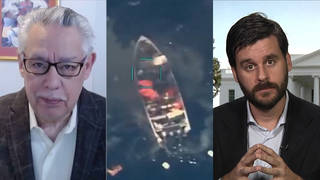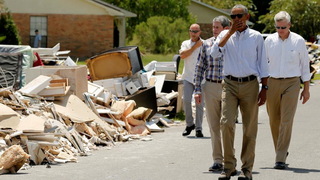
As thousands of gallons of oil continue to spew daily from a damaged well in the Gulf of Mexico, representatives from BP, Transocean and Halliburton were grilled by lawmakers in back-to-back hearings on Capitol Hill Tuesday. Industry executives from all three corporations began with prepared testimony that involved blaming each other for the explosion and deflecting responsibility for the unfolding environmental and economic disaster. We air excerpts and speak with marine biologist Rick Steiner. For the past week he has been working at the site of the oil spill and on the Louisiana coast, where he collected several samples of the oil washing up ashore. [includes rush transcript]
Transcript
AMY GOODMAN: As thousands of gallons of oil continue to spew daily from a damaged well in the Gulf of Mexico, representatives from BP, Transocean and Halliburton were grilled by lawmakers in back-to-back hearings on Capitol Hill Tuesday. Industry executives from all three corporations began with prepared testimony that involved blaming each other for the explosion and deflecting responsibility for the unfolding environmental and economic disaster.
This clip includes Halliburton president and chief health safety and environment officer Tim Probert, Transocean CEO Steven Newman, and BP America chairman and president Lamar McKay.
LAMAR McKAY: There are really two key sets of questions here, and we’re actively exploring both of them. First, what caused the explosion and fire onboard Transocean’s Deepwater Horizon rig? Second, why did Transocean’s blowout preventer, the key failsafe mechanism, fail to shut in the well and release the rig?
TIM PROBERT: At the outset, I need to emphasize that Halliburton, as a service provider to the well owner, is contractually bound to comply with the well owner’s instructions on all matters relating to the performance of all work-related activities.
STEVEN NEWMAN: The one thing we do know is that on the evening of April 20th, there was a sudden catastrophic failure of the cement, the casing, or both. Without a failure of one of those elements, the explosion could not have occurred. It is also clear that the drill crew had very little, if any, time to react. The initial indications of trouble and the subsequent explosions were almost instantaneous.
AMY GOODMAN: That last person, Transocean CEO Steven Newman.
Well, senators accused all three companies of trying to pass the buck and of making disastrously off-base pre-drilling safety assurances. The chair and president of British oil giant BP swore his company would take responsibility for the cleanup and said, quote, “We are prepared to clean up and deal with anything that gets on shore, and we’re prepared to deal with the economic impact.”
Wisconsin Democratic Senator Maria Cantwell — Washington Democratic Senator Maria Cantwell grilled Lamar McKay about exactly what BP was going to pay for.
SEN. MARIA CANTWELL: It literally was just last year that the last parts of the Exxon Valdez cleanup were settled. I mean, it was a twenty-year process. It went all the way to the Supreme Court. So, Mr. McKay, are you saying you’re going to avoid that by paying legitimate claims in advance? I know you can’t stop anybody from suing you, but are you saying you’re going to pay legitimate claims in advance of any court process?
LAMAR McKAY: We are paying legitimate claims right now, and so, yes, I am. And obviously we can’t keep from being sued, but, yes, we have said exactly what we mean. We’re going to pay the legitimate claims.
SEN. MARIA CANTWELL: OK, so if it’s a legitimate claim, a harm to the fishing industry, both short term and long term, you’re going to pay?
LAMAR McKAY: We’re going to pay all legitimate claims.
SEN. MARIA CANTWELL: If it’s an impact for business loss from tourism, you’re going to pay?
LAMAR McKAY: We’re going to pay all legitimate claims.
SEN. MARIA CANTWELL: To state and local governments for lost tax revenue, you’re going to pay?
LAMAR McKAY: Question mark.
SEN. MARIA CANTWELL: Long-term damages to the Louisiana fishing industry and its brand?
LAMAR McKAY: I can’t — I can’t quantify or speculate on long term. I don’t know how to define it.
SEN. MARIA CANTWELL: Additional troubles from depleted fisheries in their recovery?
LAMAR McKAY: We’re going to pay all legitimate claims.
SEN. MARIA CANTWELL: Shipping impacts?
LAMAR McKAY: Legitimate claims.
SEN. MARIA CANTWELL: Impacts on further drilling operations? I’m talking about things now that were part of the Exxon Valdez. So I guess what I’m saying is I think the American people are most anxious about this.
AMY GOODMAN: Washington Senator Maria Cantwell questioning BP America chair Lamar McKay. McKay also assured Oregon Democratic Senator Ron Wyden that BP was changing its practices, but then refused to acknowledge any deficiencies in its operation management systems in the Gulf of Mexico.
SEN. RON WYDEN: This sure fits, in my view, a pattern — a pattern — of serious safety and environmental problems at BP. And the company always says the same thing after one of these accidents: “We’re going to toughen up our standards. We’re going to improve management. We’re going to deal with risk.” And then another such accident takes place.
LAMAR McKAY: We are changing this company. We’ve put in management systems that are covering the world in a consistent and rigorous way.
SEN. RON WYDEN: Well, then tell me, if you would, what management systems you put in that would have taken all possible precautions against this kind of problem, because it seems to me I’m hearing about reports of various things that others in the industry are doing, various kinds of computer models and the like that they test. What specifically have you done to put in place changes that reduce the likelihood of these kinds of accidents that BP has a history of being involved in?
LAMAR McKAY: Well, I believe our operating management system in the Gulf of Mexico is as good as anyone. I can’t point to any deficiencies to point out to you. The investigations are obviously going to be important in terms of if there was something missed. I know of nothing that points me in a direction that we have deficiencies in our operating management system.
AMY GOODMAN: That’s BP America chair and president Lamar McKay being questioned by Oregon Senator Wyden.
Well, I’m joined right now by Rick Steiner, a marine biologist. For the past week he’s been working at the site of the oil spill and on the Louisiana coast, where he collected several samples of the oil washing ashore. He’s a former University of Alaska fisheries extension agent and very familiar with the impact of the Exxon Valdez spill. He just returned to Alaska from the Louisiana coast a couple of hours ago and joins us on the phone from there.
Rick Steiner, as you’re listening to this testimony for the first time, what are your thoughts, as they talk, the chair, CEO of BP America talks about reimbursing legitimate claims?
RICK STEINER: Good morning, Amy. Yeah, I just got back here about two hours ago to Alaska from the Gulf. And I was glad to hear this questioning in the Senate committees there yesterday. And of course BP is playing — all of these companies — Transocean; Cameron Industries, the maker of the blowout preventer; Halliburton; and BP — are all playing the blame game now.
BP has committed several very serious environmental crimes over the last ten to twenty years, a couple of them right here in Alaska that led to major oil spills on the North Slope, the nation’s largest oil field. So, and whoever the questioner was got it right: every time there’s a breakdown, BP promises that they will change their corporate culture and manage risks better and make a major restructuring within the company so that these things don’t happen, and yet they continue to happen. The Texas City refinery blast was another tragic example. And certainly, the Deepwater Horizon spill, I mean, if he says he doesn’t see anything wrong with their management structure, does he know that the Deepwater Horizon spill has occurred and the rig blew up and sank and they lost eleven workers there? I mean, my goodness.
AMY GOODMAN: Rick Steiner, tell us what you found on the coast.
RICK STEINER: Well, it’s very — it’s tragic, actually. I mean, all these spills that we’ve worked on around the world, they have their own similarities and differences, but this one’s really historic in a number of ways. It’s the largest, deepest blowout in history. It’s coming out at 5,000 feet deep, as people know, and about fifty miles offshore. And it’s a light Gulf of Mexico crude, so it’s got some things different than the Exxon Valdez, for instance. By the — when the oil comes out of the wellhead, the blowout, it’s emulsifying very quickly with this very dense, high-pressure seawater. And then these things act in complicated ways, where then the plume will rise a few hundred meters, and some research has shown that in smaller blowouts in a little bit shallower water that then the plume will stabilize at a particular depth, that it will reach a terminal depth, and then just start flowing subsurface. So I think the easy way to look at this is that a lot of the oil that’s come out still probably hasn’t surfaced yet. But even the stuff that has surfaced, it’s covering two to three thousand square miles in broken patches. I mean, it’s not solid, but broken patches. If you use the conservative estimate that BP is putting out and the government apparently is concurring with, then there’s four to five million gallons that have come out so far over the last three weeks. And it’s a very complicated event.
The cause seems like a combination of human error, when they withdrew the muds from the well stem and replaced it with seawater before the concrete plugs were in, and then mechanical failure, when the blowout preventer failed, as well.
So the response — you know, the other thing we’ve learned from spills all over the world is that response just simply never works. And it never has and likely never will. Seldom is more than ten percent that is spilled actually recovered from the sea surface. So, you know, they’re very proud to say they’ve got 13,000 workers on this and 400-some boats and, you know, a million feet of boom and things like that, but the sad bottom line is they’re not going to be able to contain and recover much of the oil from the environment. It just simply hasn’t happened. I was watching a lot of shrimp boats pull containment booms through the oil, and the oil was unfortunately so saturated with water that when the booms contacted the oil, it just went beneath the booms, and there was as much oil behind the booms as inside of it. So they’re recovering, you know, three million gallons or so of oil-water mixture, but about 90 percent of that is likely water. So, at any rate, yeah, it’s a lot of oil in the water. It’s still coming.
The cause is obviously negligence and mechanical failure. And the impact of this thing has been quite serious. But it’s so different from a normal tanker spill, for instance, where all the oil is on the surface, at least to start with, and you can follow it. This oil is coming out at 5,000 feet deep, so a lot of the impact — and plus when it emulsifies with water and the methane dissolves off — a lot of the impact of this oil, this subsurface toxic plume, will be in the deep ocean and what we call the pelagic ecosystem. And that — that is a serious ecosystem. And that’s — you know, that’s a very rich ecosystem offshore there, several kinds of whales, dolphins. We spent an afternoon with a pod of fifty bottlenose dolphins out in and around the oil, thousands of seabirds. So, you know, there’s this traditional bias or chauvinism that — in oil spills, that we’re only concerned if the oil comes onshore and with the oil on the surface. Well, in this, we are concerned about that — the oil has started coming onshore, and there’s a lot on the surface — but because of the turbulent mixing energy of the wind and waves and also the chemical dispersant that they’ve applied, some 300,000 gallons of this stuff to the surface slicks, there’s a lot of this oil that’s down in the water column. And so, while that might be good if you’re a seabird, it’s not if you’re a bluefin tuna that’s getting ready to spawn.
And one other last thing about impact. There’s a lot of very precious, very unusual marine habitats in the Gulf of Mexico. There’s some deepwater coral reefs up on the — as you start going up the continental shelf. And then there’s these cold seeps where methane, this natural gas, just percolates out of the seabed and forms these really rich, unusual biological communities, extremely productive, that live just simply off the methane coming out of the seabed, and a number of endemic species that are found nowhere else. And I think, because a lot of this oil is entrained in the deepwater masses, likely, that some of these very productive special habitats will be hit. And we need to take a good look at that, so…
AMY GOODMAN: Rick Steiner, it’s interesting that you’ve gone from the Louisiana coast back home to Alaska. How is Alaska doing after Exxon Valdez some twenty years later? It was an issue that the Washington Senator Cantwell also raised.
RICK STEINER: Well, it’s a very good question. And unfortunately, the injured ecosystem is far from recovered. We still have some amounts of Exxon Valdez oil in the beaches here, you know, twenty or thirty thousand gallons down deep in the beaches, which is still relatively toxic, interestingly. Most of the injured populations that the government scientists have been monitoring have still yet to fully recover. Some critical prey species in the system — Pacific herring, for instance — aren’t recovering at all twenty-one years later. That was a surprise. All of their young were killed in 1989, because they were exposed directly to the oil. But the adults survived for a few years, until a viral disease became epidemic, because their immune response was suppressed due to oil toxicity, likely. So the ecosystem is far from recovered.
The human communities that rely on the marine ecosystem are still in somewhat turmoil. I think that Maria Cantwell mentioned the final settlement for the private plaintiffs here, for some 30,000 plaintiffs. It was cut down from $5 billion, sequentially, all the way down to $500 million on appeals, these incessant, persistent appeals that Exxon lawyers kept filing. So it took twenty years for people to get compensated. You know, I remember a few weeks into the spill, one of the guys in the industry pulled me aside at the command center and said, “You know, the word around the oil business here is that lawyers yet to be born will work on this oil spill.” And I kind of laughed it off, thinking that was impossible. But here we are twenty-one years later. Another point is the government still has not collected its final check of $92 million from Exxon.
So, you know, these things can be devastating. There’s no way to restore a spill-injured ecosystem. There’s really no way to rehabilitate oiled wildlife successfully, and there’s very little way to adequately compensate human communities whose lives have been turned upside down by these kinds of things. So it’s all bad. There’s no good. The one potential silver lining to this disaster may be if we finally get the lesson learned that we need sustainable energy policies in this country. I think it’s enormously callous and insensitive for the Kerry-Lieberman bill to be introduced today or tomorrow, whenever it’s going in, and still including all this OCS, Outer Continental Shelf, drilling, when we know — I mean, we know right now the costs of this kind of risk. So we shouldn’t be drilling in the deep ocean at 5,000 feet if we can’t come up with a sufficient contingency plan for such a blowout scenario. We shouldn’t be drilling in the Arctic Ocean, where it would be absolutely impossible to control a blowout or to respond to oil in broken sea ice. So that needs to get pulled. The risk is simply too great.
AMY GOODMAN: Rick Steiner, we want to thank you for being with us, marine conservation specialist, professor at the University of Alaska, has just flown back to Alaska after being on the Louisiana coast.












Media Options